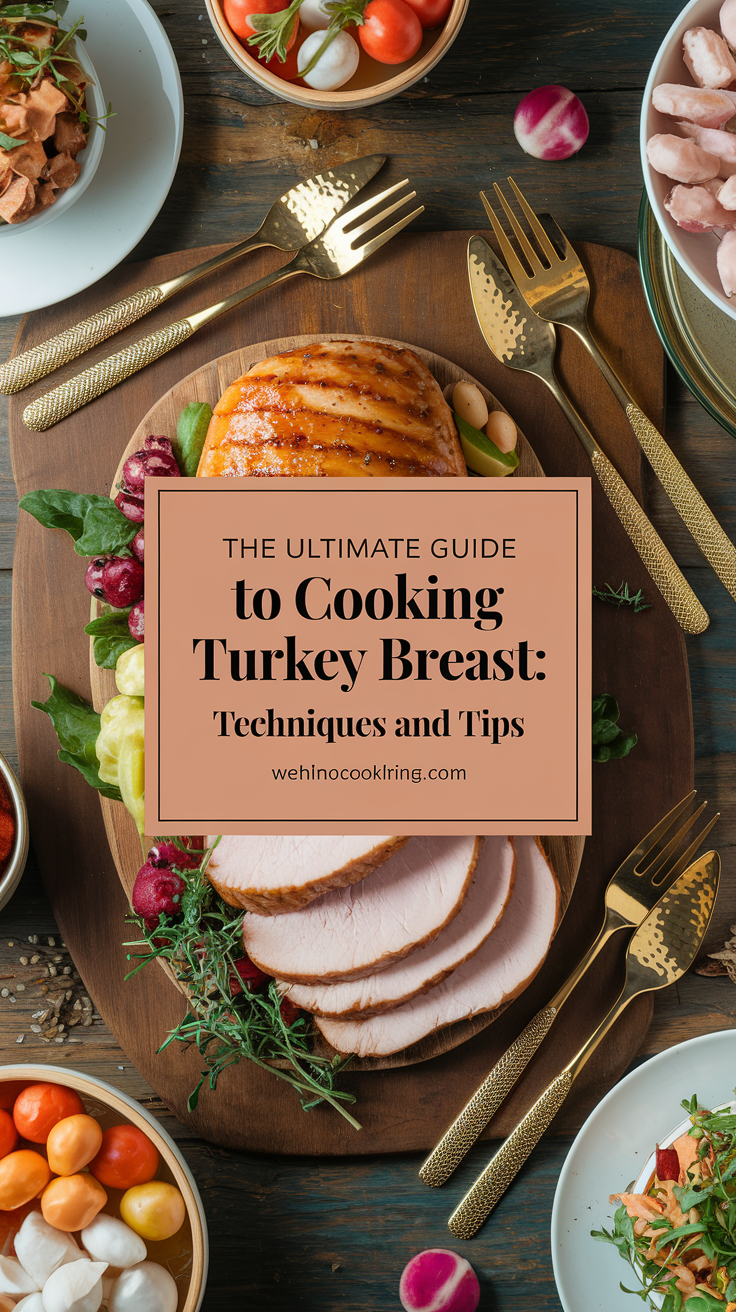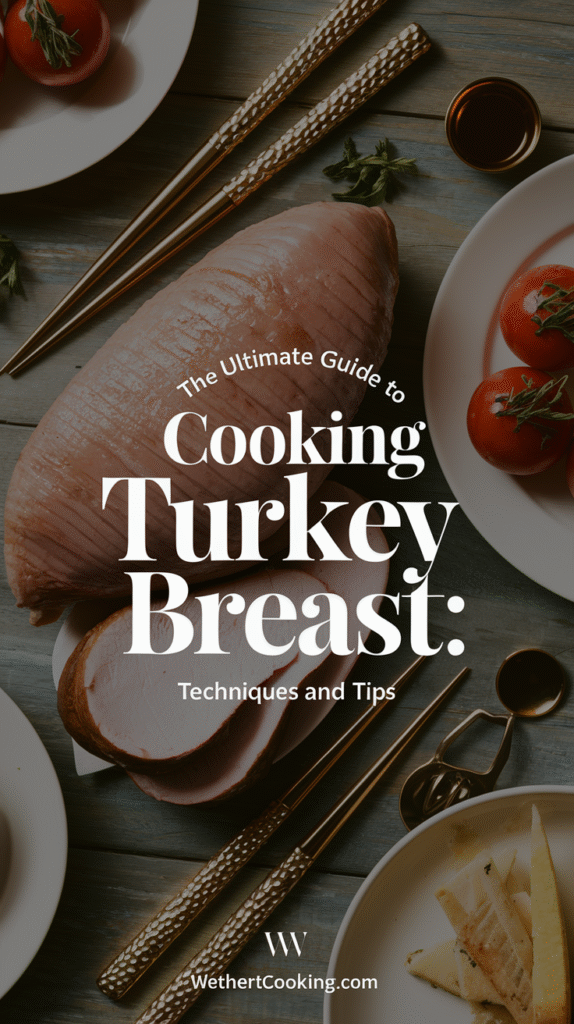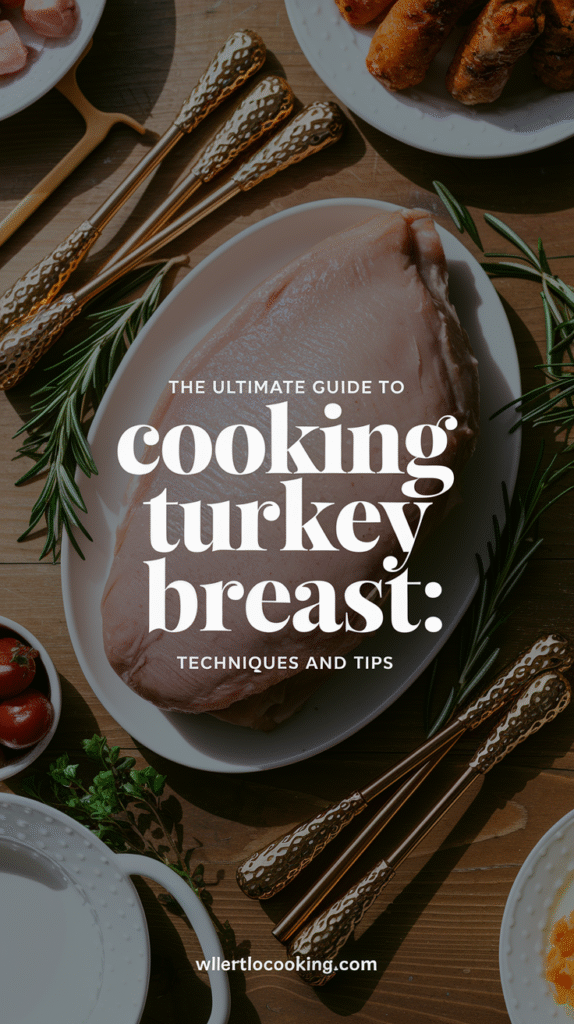Cooking turkey breast can be a delightful experience, whether you’re preparing a holiday feast or a simple weeknight dinner. This versatile protein is healthy and easy to cook, making it an excellent choice for many occasions. Here, you’ll find some techniques and tips to ensure your turkey breast turns out juicy and flavorful every time.
Choosing the Right Turkey Breast
Before you start cooking, it’s essential to select a quality turkey breast. You can choose between fresh and frozen turkey. If you go for frozen, plan to thaw it in the refrigerator for 24 hours for every 4-5 pounds to ensure even cooking.
- Bone-in vs. Boneless: Bone-in turkey breasts tend to be juicier, while boneless versions are easier to slice.
- Organic vs. Conventional: Organic turkeys generally have better flavor and are raised without antibiotics.
Preparation Techniques
Proper preparation can make a significant difference in your final dish. Here are some methods to enhance the flavor and texture of your turkey breast:
- Brining: Soaking your turkey breast in a saltwater solution for several hours can infuse moisture and flavor. A basic brine includes water, salt, and sugar. For added flavor, consider adding herbs and spices.
- Dry Rubs: Using a combination of spices directly on the turkey breast enhances the taste. Popular options include garlic powder, paprika, black pepper, and thyme.
- Marinades: Marinate the turkey breast with a mixture of oil, vinegar, citrus juice, and your favorite herbs for at least an hour, or overnight for even more flavor.
Cooking Methods
There are several methods to cook turkey breast, each delivering delicious results.
Baking
Baking is a traditional and straightforward method. Preheat your oven to 325°F (165°C). Place your seasoned turkey breast in a roasting pan and cook until the internal temperature reaches 165°F (74°C), usually about 20 minutes per pound.
Grilling
Grilling adds a unique flavor and is perfect for warm weather. Preheat your grill to medium heat. Cook the turkey breast for about 5-7 minutes per side, depending on the thickness, until it reaches the right temperature.
Slow Cooking
If you prefer a hands-off approach, a slow cooker is an excellent option. Place the seasoned turkey breast in the slow cooker with a cup of broth or water. Cook on low for 6-7 hours or on high for 3-4 hours.
Air Frying
Air fryers can produce crispy skin while keeping the meat juicy. Preheat your air fryer to 360°F (182°C), cook for about 25-30 minutes, and ensure the internal temperature reaches 165°F (74°C).
Resting and Slicing
After cooking, let your turkey breast rest for at least 10-15 minutes. This step is crucial. Resting allows the juices to redistribute throughout the meat, preventing them from running out when sliced.
Use a sharp knife to carve the turkey breast at a slight angle, cutting against the grain for tender slices.
Serving Suggestions
Turkey breast can be served in numerous ways. Here are some ideas to elevate your meal:
- Sandwiches: Leftover turkey makes a satisfying sandwich.
- Salads: Toss sliced turkey on mixed greens for a healthy lunch.
- With Sides: Pair it with traditional side dishes like stuffing, cranberry sauce, and roasted vegetables for a complete feast.
Helpful Resources
For more tips on cooking turkey breast, consider checking out reputable cooking websites like Food Network or Allrecipes. These sites provide a wealth of recipes and methods to enhance your turkey cooking skills.
By following these techniques and tips, you can effortlessly master cooking turkey breast. With the right preparation and cooking methods, it will not only be easy to achieve a delicious meal but also an enjoyable experience for you and those you serve.
Flavorful Marinades and Rubs for Turkey Breast
To create a flavorful turkey breast, marinades and rubs are essential. They not only enhance the taste but also help in tenderizing the meat. Below are various marinades and rubs that can give your turkey breast an incredible flavor. You’ll want to choose one that suits your taste preferences for any occasion, whether it’s a holiday meal or a casual dinner.
Best Marinades for Turkey Breast
Marinades are a blend of oils, acids, and spices that soak into the meat, adding moisture and flavor. Here are some options you might enjoy:
- Herb Citrus Marinade: Combine the juice of 2 lemons and 2 oranges with ¼ cup of olive oil, 2 tablespoons of chopped fresh herbs like rosemary and thyme, salt, and pepper. Marinate the turkey breast for at least 2 hours, ideally overnight.
- Garlic and Honey Marinade: Mix ½ cup of honey, 1/4 cup soy sauce, 4 minced cloves of garlic, and 2 tablespoons of apple cider vinegar. This marinade gives a perfect sweet and savory taste and should marinate for 4–6 hours.
- Spicy Chipotle Marinade: Blend 2 chipotle peppers in adobo sauce with ¼ cup lime juice, 2 tablespoons olive oil, and a pinch of salt. This spicy option adds a great kick and should marinate for 1 to 3 hours.
Flavorful Rubs for Turkey Breast
If you prefer a dry rub, there are plenty of spice mixes that can elevate the taste of your turkey breast. Here are three of the most popular:
- Classic Poultry Rub: Combine 1 tablespoon each of salt, pepper, garlic powder, onion powder, and dried thyme. This timeless mix will complement the natural flavors of the turkey.
- Sweet and Smoky Rub: Blend 1 tablespoon brown sugar, 1 tablespoon smoked paprika, 1 teaspoon cumin, and 1 teaspoon chili powder. This rub gives a smoky depth and a hint of sweetness.
- Asian-Inspired Rub: Mix 1 tablespoon sesame seeds, 1 teaspoon five-spice powder, and ½ teaspoon salt. This Asian twist can be used for a unique flavor profile.
How to Apply Marinades and Rubs
The key to maximizing flavor is in how you apply marinades and rubs. Here’s how to do it:
For Marinades: Place your turkey breast in a resealable plastic bag or a bowl. Pour in the marinade, ensuring the meat is fully coated. Seal the bag or cover the bowl and refrigerate for the recommended time. Remember, the longer you marinate, the more flavor it will absorb.
For Rubs: Pat the turkey breast dry with paper towels before applying the rub. Rub the spice mix all over the meat, making sure to get into all the crevices. Let it sit for at least 30 minutes before cooking; for deeper flavor, leave it in the fridge for several hours.
Cooking Tips for Perfect Turkey Breast
Regardless of whether you marinate or rub your turkey breast, cooking techniques also matter. Here are some insider tips:
- Use a Meat Thermometer: Cook until the internal temperature reaches 165°F (74°C) for juicy, perfectly cooked meat.
- Let it Rest: After cooking, allow your turkey breast to rest for at least 10 to 15 minutes before slicing. This helps keep the juices in the meat.
- Experiment with Wood Chips: If you’re using a grill or smoker, try adding wood chips like hickory or apple for added flavor.
By choosing the right marinades and rubs, you can turn an ordinary turkey breast into an extraordinary meal. Don’t be afraid to mix and match ingredients to find your perfect combination. You can explore more recipes and cooking tips at [Eat Smarter](https://www.eatsmarter.com) and [Serious Eats](https://www.seriouseats.com) for further inspiration on how to cook turkey breast to perfection.
Cooking Turkey Breast: Oven vs. Slow Cooker
When it comes to cooking turkey breast, choosing the right method can make a significant difference in flavor, texture, and moistness. Two popular methods are oven roasting and using a slow cooker. Each method has its advantages and particularities, making them suitable for different occasions and personal preferences. Here’s a detailed look at both methods to help you decide which one is right for your next turkey breast meal.
Cooking Turkey Breast in the Oven
Using an oven to cook your turkey breast is a classic choice that yields crispy skin and a rich, savory flavor. Here’s how you can do it:
- Preparation: Start by thawing your turkey breast if it’s frozen. Once thawed, pat it dry with paper towels. Season it with salt, pepper, and any other herbs or spices you enjoy.
- Cooking Temperature: Preheat your oven to 325°F (163°C). This lower temperature helps keep the turkey moist.
- Cooking Time: A general rule of thumb is to cook the turkey breast for about 20 minutes per pound. For instance, a 4-pound breast will take about 1 hour and 20 minutes.
- Internal Temperature: Use a meat thermometer to check the internal temperature, which should reach at least 165°F (74°C) in the thickest part of the breast.
- Resting: After removing it from the oven, let the turkey breast rest for at least 15-20 minutes before slicing. This helps the juices redistribute, making the meat more tender.
Oven-roasted turkey breast is perfect for gatherings or holiday dinners. It also allows you to make use of the drippings for a delicious gravy.
Cooking Turkey Breast in a Slow Cooker
The slow cooker method is an excellent option if you are looking for convenience and an easy cleanup. Here’s what you need to know:
- Preparation: Just like with the oven method, start by thawing and seasoning your turkey breast. You can add vegetables like carrots, potatoes, and onions to enhance the flavor.
- Cooking Temperature: Set your slow cooker on low for optimal results. This will allow the turkey to cook evenly and absorb the flavors.
- Cooking Time: Cook the turkey for about 6-8 hours on low or 3-4 hours on high, depending on the size of the breast.
- Internal Temperature: Aim for the same target of 165°F (74°C) for safety and optimal texture.
- Moisture Retention: A slow cooker traps steam, which means your turkey breast will be incredibly moist and tender.
The slow cooker method is perfect for busy days when you want to set it and forget it. You’ll return to a wonderfully cooked turkey breast without needing additional monitoring. Plus, slow-cooked turkey lends itself well to shredding for sandwiches or tacos.
Comparative Overview
| Aspect | Oven | Slow Cooker |
|---|---|---|
| Texture | Crispy skin, savory | Moist, tender |
| Preparation Time | More hands-on, requires monitoring | Set-and-forget, minimal monitoring |
| Cooking Time | Shorter (about 20 minutes per pound) | Longer (6-8 hours on low) |
| Flavor | Rich, deeper flavor from roasting | Subtle flavors, enhanced by added ingredients |
The choice between cooking turkey breast in an oven or a slow cooker largely depends on your schedule, desired texture, and flavor preferences. If you are making turkey breast for a festive occasion where presentation matters, the oven may be your best bet. However, for simple weeknight meals or when you’re busy, the slow cooker offers unmatched convenience.
For more tips and recipes on cooking turkey breast, check out Food Network and AllRecipes. Happy cooking!
Side Dishes That Pair Perfectly with Turkey Breast
Cooking turkey breast is a popular choice for many families, especially during festive seasons. While the turkey itself is the star of the meal, selecting the right side dishes can elevate your feast to a whole new level. Here are some perfect pairings that will not only complement the flavors of your turkey breast but also add color and variety to your plate.
Classic Vegetable Sides
Vegetables always make a delightful pairing with turkey breast. Here are some timeless options:
- Green Beans Almondine – Sautéed green beans topped with toasted almonds provide a crunchy, fresh contrast to the turkey.
- Roasted Brussels Sprouts – Drizzle them with balsamic glaze for a sweeter tang that matches the savory turkey.
- Garlic Mashed Potatoes – Creamy mashed potatoes infused with garlic make for an irresistible side that works well with turkey.
Hearty Starches
A substantial starch can be a great addition to your turkey meal, creating a wonderfully filling platter. Here are a few delicious options:
- Stuffing/Dressing – Traditional stuffing, either cooked inside the turkey or separately, adds herbs and moisture to your meal.
- Sweet Potato Casserole – A sweet and buttery dish with a crunchy topping can balance the savory flavors of your turkey.
- Wild Rice Pilaf – Combining wild rice with nuts and dried fruits brings a unique flavor profile that pairs nicely with turkey.
Flavorful Sauces
Adding sauces is a fantastic way to enhance each bite of turkey. Consider these options:
- Cranberry Sauce – A classic side that adds a tart, sweet flavor complementing the rich taste of turkey.
- Gravy – A must-have for many, turkey gravy made from drippings makes each slice moist and flavorful.
- Herbed Butter – Softened butter mixed with herbs and spices can be melted over turkey for an extra layer of flavor.
Refreshing Salads
A light salad can be a wonderful side to offset the richness of the turkey. Consider these refreshing options:
- Caesar Salad – The crunchy lettuce and creamy dressing balance the turkey’s flavor beautifully.
- Spinach and Strawberry Salad – This sweet and tangy salad can add a refreshing sweetness to the meal.
- Quinoa Salad – Combining quinoa with vegetables and feta offers a healthy, protein-rich option.
Classic Pairing Table
| Side Dish | Flavor Profile | Preparation Time |
|---|---|---|
| Green Beans Almondine | Crunchy, Fresh | 15 minutes |
| Sweet Potato Casserole | Sweet, Buttery | 45 minutes |
| Cranberry Sauce | Tart, Sweet | 30 minutes |
| Caesar Salad | Creamy, Savory | 10 minutes |
Should you wish to go beyond traditional pairings, explore variations and regional flavors. For example, incorporating spicy dishes like jalapeño cornbread or chili-infused sides can add excitement to your turkey feast.
As holiday tables fill up with delectable turkey breast, remember that balance and variety are key. Each side dish contributes its unique taste, enhancing the turkey’s flavor while creating a colorful presentation.
For more recipes and tips on cooking turkey breast, visit Food Network or explore delicious variations at AllRecipes.
Prepare for joyful gatherings with these side dishes that promise to make your turkey breast even more memorable!
Troubleshooting Common Issues When Cooking Turkey Breast
Cooking turkey breast can be a rewarding task, especially during special occasions or festive meals. However, various issues may arise that can affect the quality of your turkey. Understanding how to troubleshoot these common issues will help ensure a delicious meal that you can enjoy with family and friends. Below are some frequent problems and their solutions that can make your turkey breast cooking experience smoother.
Dry Turkey Breast
One of the most common complaints is dry turkey breast. This can happen for several reasons:
- Cooking Too Long: Overcooking the turkey breast leads to dryness. Make sure to cook at the right temperature.
- Insufficient Basting: Basting the turkey helps retain moisture. If you skip this step, the meat can dry out.
- Not using a Marinade: A good marinade can help lock in moisture. Consider brining your turkey breast before cooking it.
To resolve dryness, consider using a meat thermometer. Aim for an internal temperature of 165°F for optimal juiciness. Additionally, allowing the turkey breast to rest for at least 15 minutes before slicing can help redistribute the juices.
Undercooked Turkey Breast
Serving undercooked turkey not only affects flavor but also poses health risks. Here’s how to tackle undercooking:
- Check Internal Temperature: Use a meat thermometer to confirm that the thickest part of the breast reaches 165°F.
- Uneven Cooking: To prevent uneven cooking, let the turkey breast sit at room temperature for about 30 minutes prior to cooking.
- Smaller Cooking Portions: If you’re cooking a very small turkey breast, keep an eye on cooking time as it may vary.
To ensure thorough cooking, adjust cooking times according to the weight of the turkey. A general rule is to cook for 20 minutes per pound at 350°F.
Too Much Grease
Sometimes, turkey breast can end up greasy, especially if you have added butter or oil during cooking. Here are some tips to manage greasiness:
- Adjust Fat Content: Use a limited amount of oil or butter when preparing your turkey breast to keep the dish lighter.
- Cook on a Rack: Cooking the turkey on a rack allows the grease to drip away from the meat.
- Skim Fat: After cooking, allow the drippings to sit so that the fat separates. Skim off the top before using the drippings for gravy.
Flavor Issues
If your turkey breast lacks flavor, it can be disappointing. Here are ways to enhance its taste:
- Seasoning: Don’t skimp on seasoning. Salt and pepper are essential, but consider garlic powder, onion powder, and fresh herbs as well.
- Use a Brine: Brining the turkey breast not only adds flavor but also helps with moisture retention.
- Stuffing: Cooking with stuffing can also enhance the flavor profile. Just ensure that everything is safe to eat.
| Common Issue | Reason | Solution |
|---|---|---|
| Dry Turkey Breast | Cooked too long | Cook until 165°F and let rest |
| Undercooked Turkey Breast | Poor temperature check | Use a meat thermometer |
| Too Much Grease | Excessive fat used | Use less oil and cook on a rack |
| Flavor Issues | Inadequate seasoning | Brine and spice well |
Cooking turkey breast can seem daunting, but by following these troubleshooting tips, you can create a succulent and flavorful dish. For further assistance on cooking techniques, you can check out Roasting Turkey for detailed guides and recipes.
If you’re looking for more information on turkey recipes and cooking tips, consider visiting Food Network’s turkey section. They provide valuable insights that can assist you in perfecting your turkey breast cooking skills.
Remember, each cooking experience offers valuable lessons. Embrace any mishaps as opportunities to improve your skills. Happy cooking!
Conclusion
Mastering the art of cooking turkey breast opens up a world of delicious possibilities for your meals, whether it’s for a festive gathering or an ordinary weeknight dinner. By exploring various cooking techniques, from traditional oven roasting to the convenience of a slow cooker, you can find the method that best suits your schedule and taste preferences.
Enhancing your turkey breast with flavorful marinades and rubs brings an extra layer of depth to your dish, ensuring every bite is packed with savory goodness. Experimenting with different herbs and spices allows you to personalize your turkey, transforming a simple meal into a flavorful experience that will impress your family and friends.
Pairing turkey breast with the right side dishes can elevate your meal even further. Consider vibrant roasted vegetables, creamy mashed potatoes, or fresh salads to create a well-rounded plate. These combinations not only complement the turkey but also add color and texture, making your meal visually appealing.
It’s also important to address common cooking challenges you might face when preparing turkey breast. From ensuring the meat is perfectly cooked to troubleshooting dryness, having a clear understanding can turn potential mishaps into success stories.
With these techniques and tips in mind, you’ll be well-equipped to create a delicious turkey breast dish that showcases your culinary skills. Enjoy the journey of cooking, embrace experimentation, and savor the delightful flavors you can create in your kitchen. The next time you prepare turkey breast, remember that each step you take brings you closer to mastering this versatile dish. Happy cooking!







Leave a Reply